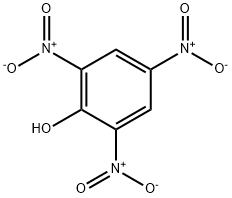PICRIC ACID suppliers
PICRIC ACID
- CAS:
- 88-89-1
- MF:
- C6H3N3O7
- MW:
- 229.1
Company Type
Properties
- Melting point:
- 122-123 °C (dried material, Lit. Merck Index 12th Ed.)(lit.)
- Boiling point:
- 300℃
- Density
- 1.00 g/mL at 20 °C
- vapor density
- 7.9 (vs air)
- vapor pressure
- 1 mm Hg ( 195 °C)
- refractive index
- 1.7630 (estimate)
- Flash point:
- 150℃
- storage temp.
- Store at RT.
- solubility
- alcohol: soluble1 (g/12 mL)(lit.)
- pka
- 0.38(at 25℃)
- form
- solution (saturated aqueous)
- Colour Index
- 10305
- Specific Gravity
- 1.005
- color
- yellow solution
- PH Range
- 0.2(colourless)-1(yellow)
- explosive limit
- 0.01%
- Water Solubility
- (mg/L):
66,670 at 100 °C (quoted, Windholz et al., 1983)
14,000 at 20 °C, 68,000 at 100 °C (quoted, Verschueren, 1983)
- λmax
- 354nm
- Merck
- 13,7492
- BRN
- 423400
- Exposure limits
- TLV-TWA skin 0.1 mg/m3 (ACGIH, OSHA, and MSHA).
- Stability:
- Stability Unstable; may detonate if struck, heated or ground. Highly flammable if dry. May explode if dry - keep wet at all times. Keep water content above 20%. Flammable. Incompatible with strong oxidizing agents, bases, most common metals, ammonia, strong reducing agents. Avoid shock, friction, heat. Compounds formed by reaction with
- Major Application
- Explosives, power circuits, energetic materials, liquefied gas fuels, thin films, power generation, batteries, fuel cells, steel, gold films, nanopowder, antifreeze fluid for automobiles, polymerization inhibitors, tattoo removal from skin, antiinfiammatroy agent, treatment of neoplasm
- InChIKey
- OXNIZHLAWKMVMX-UHFFFAOYSA-N
Safety Information
- Symbol(GHS)


GHS01,GHS06
- Signal word
- Danger
- Hazard statements
- H201-H301+H311+H331
- Precautionary statements
- P210-P230-P250-P280-P301+P310-P370+P372+P380+P373-P503
- Hazard Codes
- F,T,E,Xn
- Risk Statements
- 1-4-11-23/24/25-2-36-20/21/22-3
- Safety Statements
- 35-45-37-28-36/37-36-26-16-25
- RIDADR
- UN 1344 4.1/PG 1
- WGK Germany
- 2
- RTECS
- TJ7875000
- HazardClass
- 4.1
- PackingGroup
- I
- Toxicity
- LC50 (48-h) for red killifish 513 mg/L (Yoshioka et al., 1986).
- IDLA
- 75 mg/m3
Use
Picric acid is a white to yellowish crystalline substance, soluble in most organic solvents and highly flammable. Picric acid is a derivative of phenol. It reacts with metals to form metal picrates, which like picric acid itself are highly sensitive. It is often used for tissue fixative (Bouin solution) for histology specimens, as a booster to detonate another, less sensitive explosive, such as trinitotoluene (TNT). It is used in the manufacture of fireworks, matches, electric batteries, coloured glass, dyes, antiseptics, explosives, disinfectants, leather industries, pharmaceutical, and textile. Picric acid is also used as a yellow dye, as an antiseptic, and in the synthesis of chloropicrin, or nitro-trichloromethane. Picric acids are highly sensitive to heat, shock, or friction and because of the explosive nature it is among the most hazardous substances found in the laboratory.
According to relevant laws, regulations, policies and the provisions of this website, this website does not display the product information!
The source is "易制爆、炸药、化学武器等". If the information is inaccurate, please contact the platform to modify it.
contact information:info@chemicalbook.com 400-158-660


